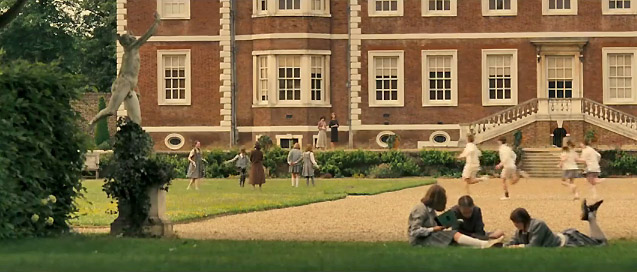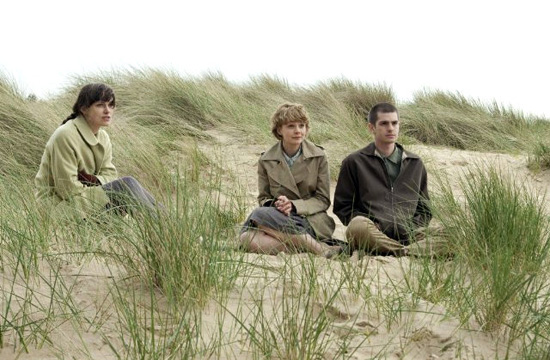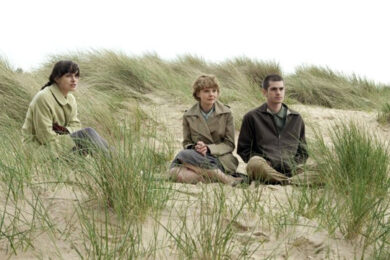The country house is enjoying quite the televisual renaissance. Over the last year we’ve had Tilda Swinton’s Italian pile in Io Sono Amore, the creepy Swedish estate in The Girl With the Dragon Tattoo and Tolstoy’s country commune in The Last Station. And if you can’t wait for the return of Downton Abbey, or the BBC’s Middlemarch, there’s always Hogwarts every dratted year.
Whether they take the form of stately homes, boarding schools, communes or secret decryption centres, these secluded settings make for great cinema and often the perfect platform for exploring the buttoned-down emotions of the British (which, in an X Factor world, are increasingly a historical curiosity).
These locations are not only about their lovely exteriors and interiors and nostalgia for a world in which everyone knew their place; cinema thrives on creating separate, enclosed worlds, be they microcosms of the world outside, or discrete environments operating within their own peculiar rules.
Never Let Me Go’s Hailsham is actually both of these. An alternative boarding school in a decaying stately home, set in what looks like the 70s, Hailsham is a perfectly realised solipsistic universe. Its very rare visitors can’t wait to get away and there are strict rules about straying into the woods. But that same rule, blurring into fairy tale amongst the kids, is indicative of the way the film is also a potent evocation of childhood itself. Shot in woody darkness inside and verdant sunlight outside, the childrens’ lives have a gauzy, nostalgic feeling to them (albeit underlain with menace).

At the school, a complex friendship develops between narrator Kathy (Carey Mulligan), geeky Tommy (Andrew Garfield) and bitchy Ruth (Keira Knightley). As Ruth and Tommy pair off and the friendship progresses into adolescence and then adulthood, the characters discover their peculiar destiny and attempt to come to terms with it. Without giving too much away, you can read the film or the original book as sci-fi, or see the children of Hailsham as kids anywhere, adapting to both the wonders and disappointments of growing up.
It was anything but clear that the film would work, however. To fans of Kazuo Ishiguro’s subtle, nuanced 2005 novel, the augurs for this adaptation weren’t good: Keira Knightley seemed too glam to portray Ruth; former music video director Mark Romanek too slick (though his promo for Johnny Cash’s ‘Hurt’ was one of the best of its genre); while The Beach and 28 Days Later writer Alex Garland seemed just too, well, populist for a story that, despite its horror and sci fi trappings, is essentially a human tragedy. In the book, as with Ishiguro’s Booker-winner The Remains of The Day (another film, another country house), it’s all about what isn’t said, what isn’t expressed.
If the film’s unnecessary prologue seems to confirm such misgivings, appearing to give away the plot’s key revelation via subtitles, Never Let Me Go quickly recovers. Because we’re soon at Hailsham, where, thankfully, there’s no skipping Knightley pretending to be eight years old. Knightley’s Ruth is initially played by Ella Purnell; Mulligan’s placid, stoical Kathy by Isobel Meikle-Small and Garfield’s twitchy Tommy by Charlie Row. The child actors are well cast both to physically resemble their adult counterparts and as actors in their own right, holding together the film’s first third, alongside the marvellous Charlotte Rampling as headmistress, Miss Emily. Yes, Miss Emily, anything you say, Miss Emily.
A word here too for the excellent Sally Hawkins (Happy Go Lucky) as kindly, wobbly teacher Miss Lucy – who is sacked for giving the game away – and for Andrea Riseborough (Made In Dagenham) and Domhnall Gleeson (The Deathly Hallows) as a young couple at ‘The Cottages’ which give the teenagers a breathing space before adult responsibility encroaches. Riseborough and Gleeson bring a kinetic intensity to the relationship that is deeply touching.
When Knightley finally does appear – at the same cottages – not only is she unglamorous of clothing and coiffure, she also makes a fair fist of mucking into the inestimable ensemble, even if she does still act with her teeth. Although Knightley might have been the biggest star at casting stage, her cohorts are now close contenders. Garfield starred in The Social Network and is soon to go viral with Spiderman. There’s little heroism here though: Garfield is gloriously geeky as Tommy, projecting a manic vulnerability alongside a ‘pull yourself together’ stiffness. Mulligan, meanwhile, seen by the producers in An Education, is set to star in Baz Luhrman’s Great Gatsby as Leo Di Caprio’s love interest.
Mulligan is an astonishingly naturalistic performer, perfect for the understated Kathy: neither character nor actor makes a fuss about anything, allowing less to be more, and thus managing to find something redemptive in even the most hopeless of situations. Kathy’s look of quiet pain when best friend Ruth steals her beloved Tommy is the more heartbreaking for being so gently undersold. But that’s as nothing as the film’s emotional body count heaps up and Kathy’s climactic scene will have even the most stoic in emotional tatters: a reaction quite uncommon in the buttoned up world of country homes.



